How to Create Actionable Meeting Minutes

Introduction
Actionable meeting minutes are the unsung heroes of productive meetings. They not only serve as a record of what transpired but also ensure that everyone is on the same page and working towards the same goals. Creating actionable meeting minutes can transform your meetings from time-consuming obligations into valuable opportunities for collaboration and progress. In this article, I will guide you through the key steps and best practices for creating meeting minutes that truly drive action and results.
Whether you're a seasoned meeting veteran or just starting to dip your toes into the world of meeting management, this article will provide you with the tools and insights needed to elevate your meeting minutes game. I'ill cover the following crucial steps:
- Set Goals for Your Meeting Minutes to ensure they serve a clear purpose
- Prepare for Your Meeting by reviewing the agenda and creating a minutes template
- Take Effective Meeting Notes that capture key information and decisions
- Review and Refine Your Meeting Minutes to improve their accuracy and readability
- Distribute Your Meeting Minutes to keep everyone informed and aligned
By the end of this article, you'll be well-equipped to create meeting minutes that not only document the proceedings but also drive meaningful action and progress.
Set Goals for Your Meeting Minutes
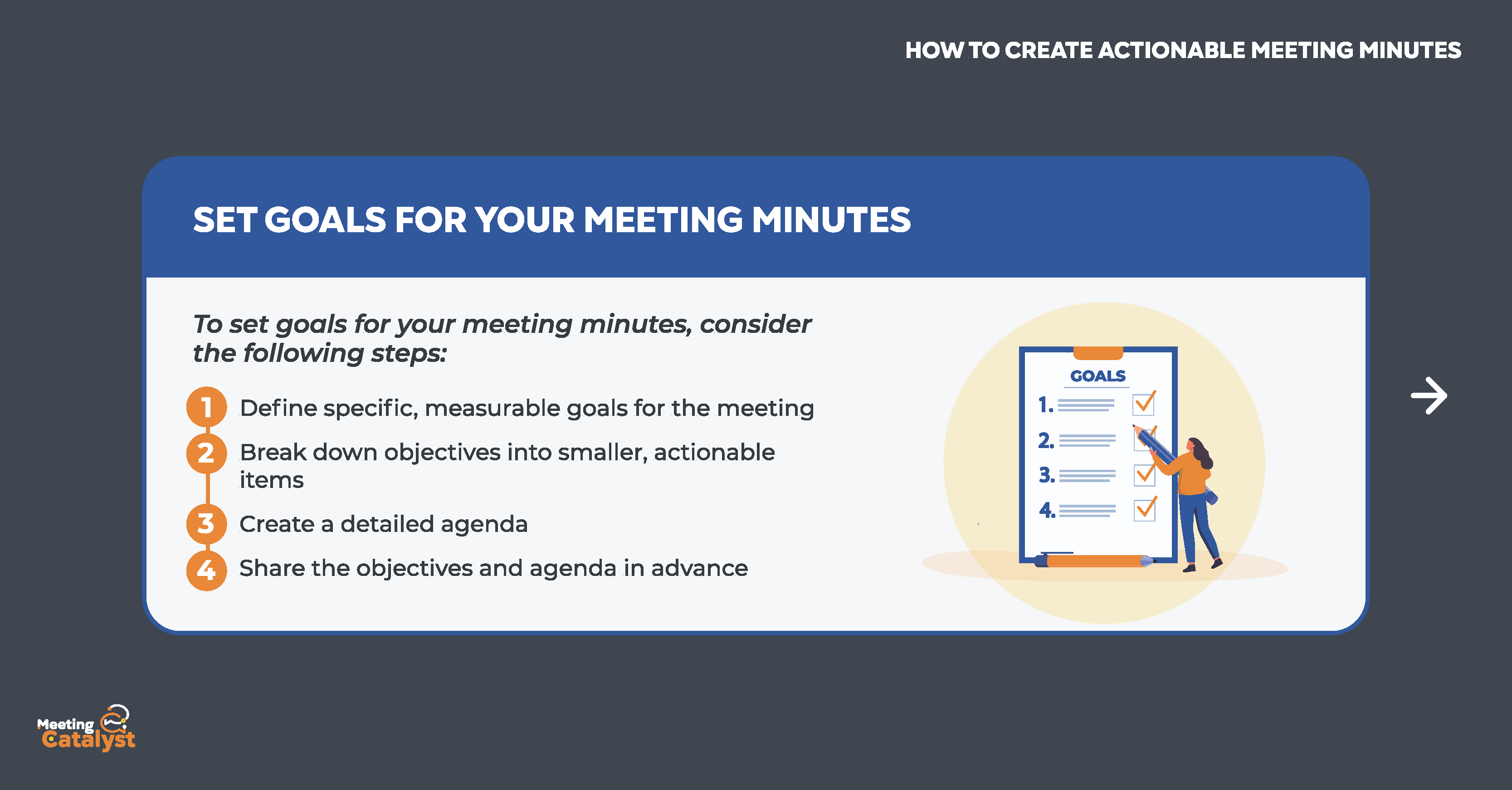
Just like any successful project, your meeting minutes should have a clear purpose and goals. Setting goals for your meeting minutes not only helps you stay focused during the meeting but also ensures that the end product is useful and actionable. In this section, we'll discuss the importance of goal-setting, provide examples of potential goals, and offer tips on prioritizing and aligning your goals with the meeting's purpose.
Importance of goal-setting: Establishing goals for your meeting minutes will guide your note-taking and help you determine which information is most critical to capture. Without clear goals, your meeting minutes may end up being a vague, unhelpful summary of the meeting.
Examples of meeting minute goals:
- Tracking action items and their owners to ensure follow-through
- Documenting key decisions made during the meeting for future reference
- Providing context and background information for stakeholders who couldn't attend the meeting
- Recording brainstorming sessions and creative ideas for further exploration
- Prioritizing and aligning your goals: Your goals should align with the meeting's purpose, and you should prioritize them accordingly. For example, if the meeting's main objective is to make critical decisions, your meeting minutes should prioritize documenting those decisions and their rationale. If the meeting is focused on brainstorming and idea generation, your minutes should capture the creative process and key ideas.
To set goals for your meeting minutes, consider the following steps:
- Review the meeting agenda and identify the primary objectives.
- Determine what information needs to be captured to support those objectives.
- Prioritize your goals based on the meeting's purpose and desired outcomes.
- Keep your goals in mind as you prepare for and attend the meeting, allowing them to guide your note-taking and focus.
By setting clear goals for your meeting minutes, you'll ensure that they are both purposeful and effective in driving action and progress within your organization.
Prepare for Your Meeting
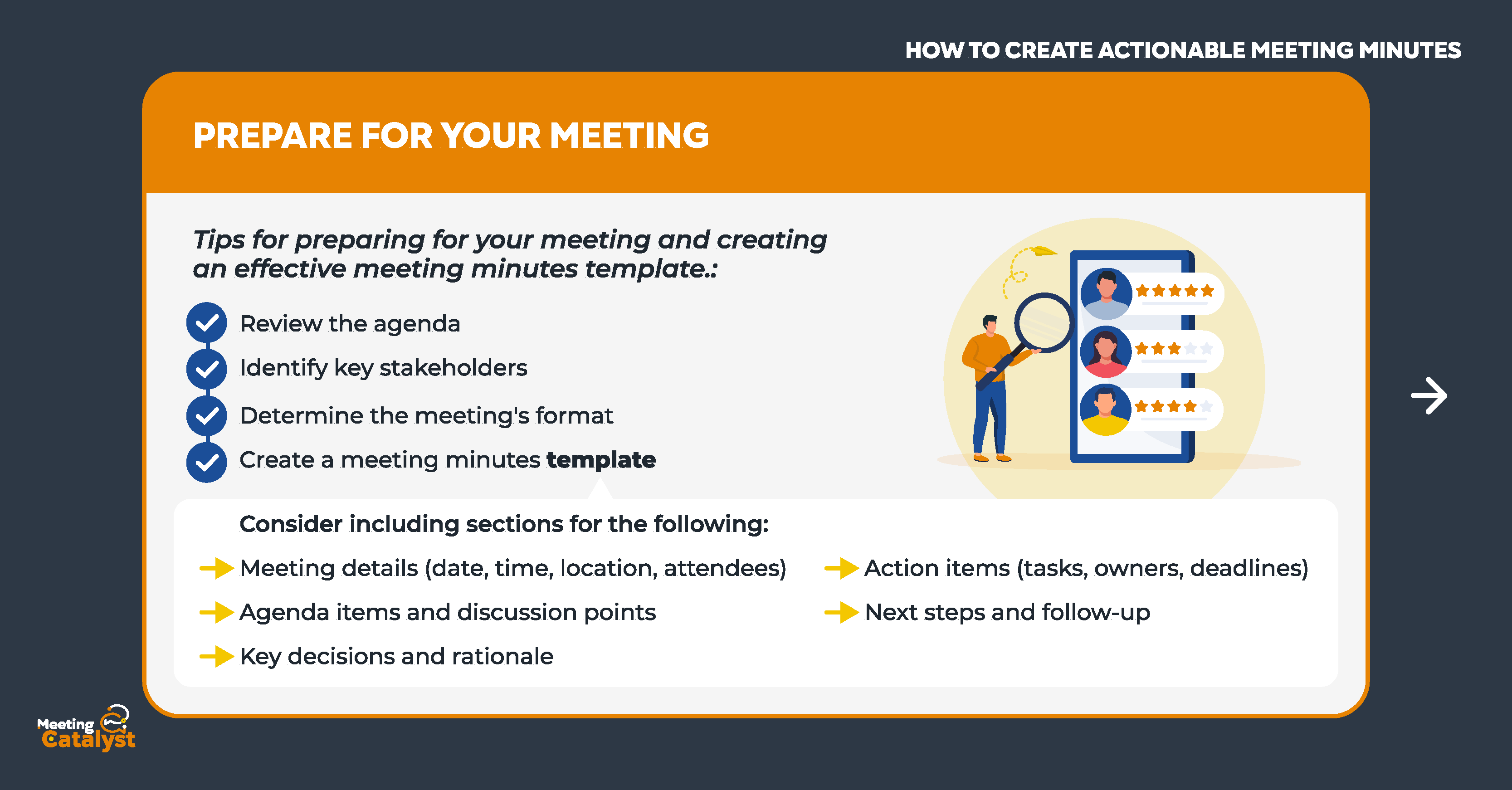
Proper preparation is crucial for creating actionable meeting minutes. By familiarizing yourself with the agenda, understanding the key stakeholders, and determining the meeting's format, you'll be better equipped to capture the most important information. Additionally, preparing a meeting minutes template in advance can streamline your note-taking process. In this section, we'll provide tips for preparing for your meeting and creating an effective meeting minutes template.
Review the agenda: Before the meeting, thoroughly review the agenda to understand the meeting's purpose, objectives, and discussion points. This will help you anticipate the key topics and decisions that should be documented in your meeting minutes.
Identify key stakeholders: Make a list of attendees, noting their roles and responsibilities within the organization. Understanding who's who will help you accurately attribute statements and decisions during the meeting.
Determine the meeting's format: Familiarize yourself with the meeting's format, whether it's a presentation, roundtable discussion, or brainstorming session. This will help you tailor your note-taking approach accordingly.
Create a meeting minutes template: A template will help you stay organized and ensure that you capture all essential information. Consider including sections for the following:
- Meeting details (date, time, location, attendees)
- Agenda items and discussion points
- Key decisions and rationale
- Action items (tasks, owners, deadlines)
- Next steps and follow-up
To create an effective template, consider these tips:
- Use clear headings and subheadings to organize your notes
- Leave space for additional comments or observations
- Include checkboxes or bullet points to denote action items
- Utilize tables or charts for complex data, if applicable
By investing time in preparing for your meeting and creating a well-organized template, you'll be in a strong position to take effective notes that result in actionable meeting minutes.
Take Effective Meeting Notes
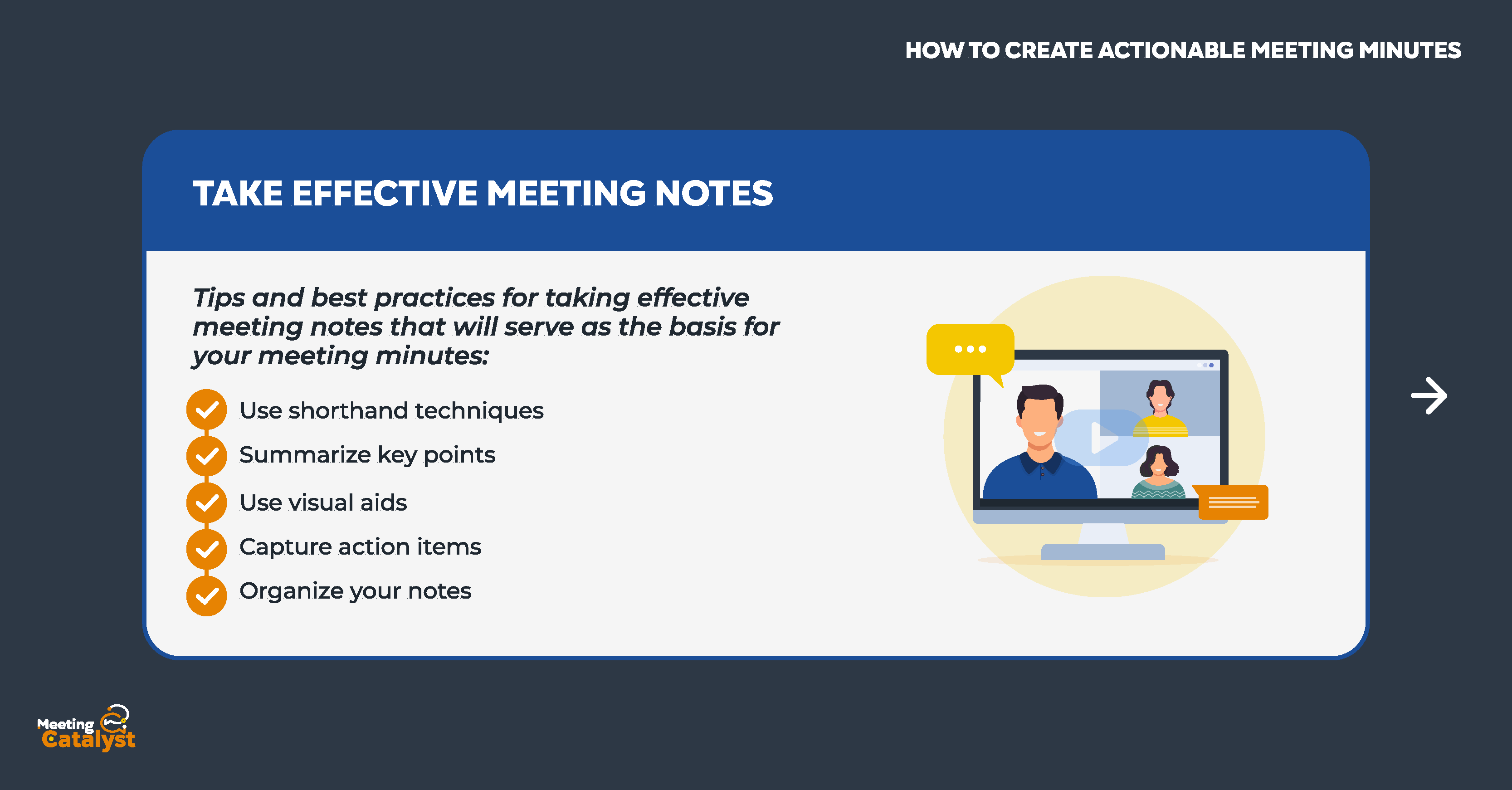
Taking effective meeting notes is the backbone of creating actionable meeting minutes. Your notes should capture key information, decisions, and insights, while remaining organized and easy to understand. In this section, we'll provide tips and best practices for taking effective meeting notes that will serve as the basis for your meeting minutes.
Use shorthand techniques: Save time and increase efficiency by using shorthand techniques, such as abbreviations, symbols, and initials. This will allow you to quickly capture information without missing crucial details.
Summarize key points: Rather than attempting to transcribe every word, focus on summarizing the main ideas, decisions, and action items. Use concise language and bullet points to keep your notes organized and easy to review.
Use visual aids: When appropriate, utilize visual aids like diagrams, charts, or mind maps to help capture complex information or relationships between ideas. Visual aids can also help jog your memory when reviewing your notes later.
Capture action items: Clearly note any action items, including the task, person responsible, and deadline. This will make it easier to identify and track action items in your meeting minutes.
Organize your notes: Use your pre-prepared template to organize your notes during the meeting. This will ensure that you're capturing all essential information and make it easier to review and refine your notes later.
Consider these additional tips for taking effective meeting notes:
- Stay focused and attentive to capture important information
- Don't be afraid to ask for clarification or to have information repeated
- If possible, collaborate with a colleague to share note-taking responsibilities
By implementing these strategies, you'll be well on your way to taking effective meeting notes that form the foundation of actionable meeting minutes.
Review and Refine Your Meeting Minutes
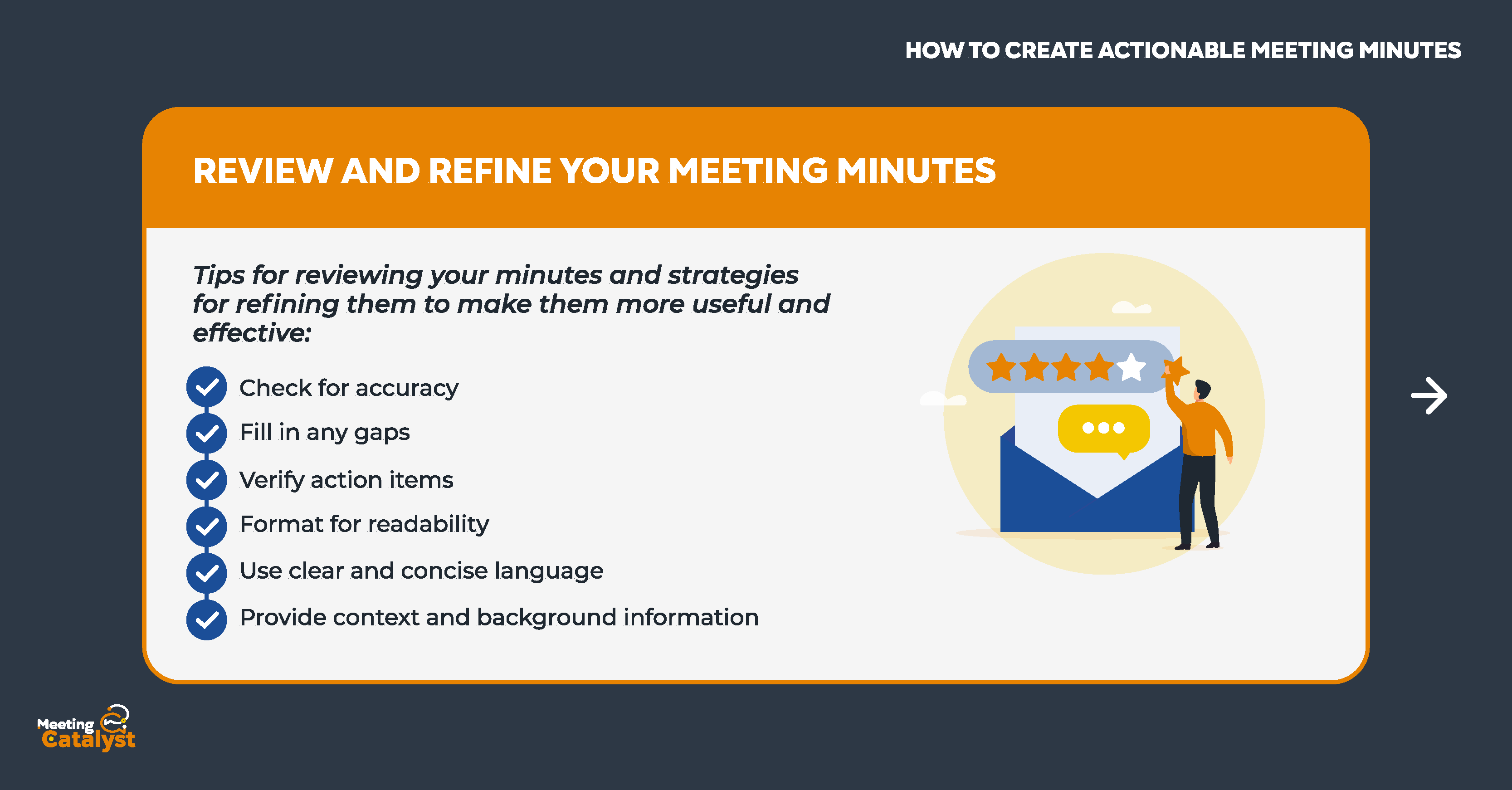
Once the meeting is over, it's crucial to review and refine your meeting minutes to ensure they're accurate, complete, and actionable. In this section, we'll discuss tips for reviewing your minutes and strategies for refining them to make them more useful and effective.
Check for accuracy: Carefully review your notes to ensure they accurately reflect the discussion, decisions, and action items from the meeting. Verify facts, figures, and names, and correct any errors or inconsistencies.
Fill in any gaps: If you notice any gaps in your notes or missing information, consult with meeting participants or any available recordings to fill in these gaps and ensure your minutes are complete.
Verify action items: Review all action items to ensure they're clear, assigned to the correct person, and have a specified deadline. This will help ensure that everyone is on the same page and action items are properly tracked and executed.
Format for readability: Organize your minutes in a clear and consistent format that's easy to read and understand. Use headings, subheadings, bullet points, and numbering to break up the text and improve readability.
Use clear and concise language: Keep your meeting minutes succinct and to-the-point by using clear, concise language. Avoid jargon, and provide explanations for any technical terms or acronyms to ensure your minutes are accessible to all readers.
Provide context and background information: For important decisions, discussions, or action items, provide relevant context and background information. This will help readers understand the rationale behind decisions and actions, and provide a useful reference for future meetings.
To review and refine your meeting minutes effectively, consider these additional tips:
- Set aside dedicated time shortly after the meeting to review and refine your minutes
- Collaborate with a colleague to review each other's minutes for a fresh perspective
- Use feedback from meeting participants to improve the quality and usefulness of your minutes
By thoroughly reviewing and refining your meeting minutes, you'll ensure they're accurate, complete, and actionable, setting the stage for successful follow-up and execution.
Distribute Your Meeting Minutes
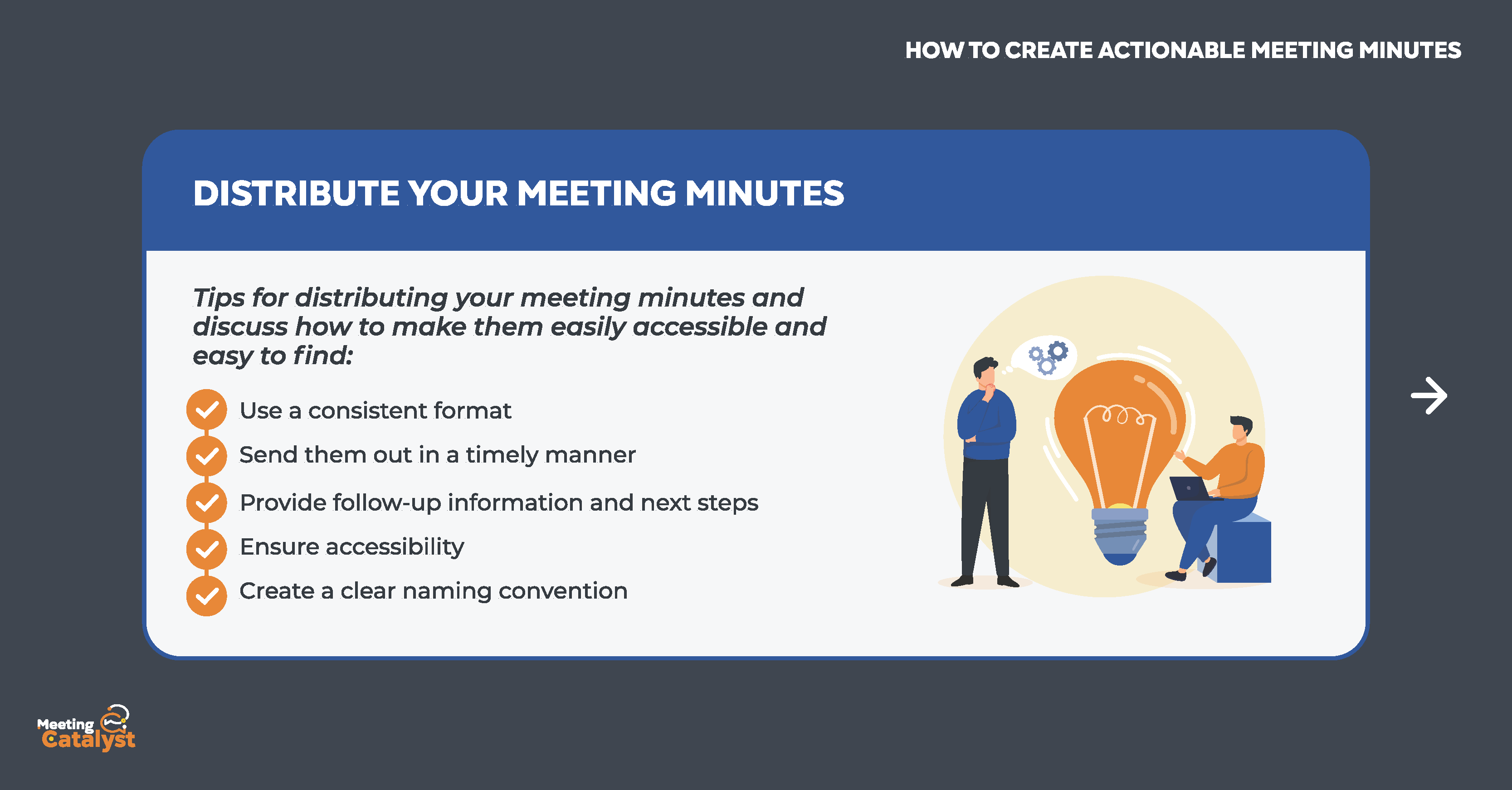
After reviewing and refining your meeting minutes, it's time to distribute them to all relevant stakeholders. Timely and effective distribution ensures that everyone is on the same page and that action items are tracked and completed. In this section, we'll provide tips for distributing your meeting minutes and discuss how to make them easily accessible and easy to find.
Use a consistent format: Distribute your meeting minutes in a consistent format that's easy to read and understand. This will help recipients quickly locate important information and ensure that your minutes are professional and organized.
Send them out in a timely manner: Distribute your meeting minutes as soon as possible after the meeting, ideally within 24-48 hours. This will ensure that the information is still fresh in participants' minds and that they can quickly act on any decisions or action items.
Provide follow-up information and next steps: When distributing your meeting minutes, include any relevant follow-up information, such as deadlines for action items, dates for future meetings, or additional resources. This will help keep everyone on track and focused on their responsibilities.
Ensure accessibility: Make your meeting minutes easily accessible to all relevant stakeholders by storing them in a shared drive, cloud-based platform, or another central location. This will make it easy for team members to reference past meeting minutes and track progress on action items.
Create a clear naming convention: Use a clear and consistent naming convention for your meeting minutes, such as including the date, meeting title, and version number (e.g., "2023-04-01_ProjectX_MeetingMinutes_v1"). This will help recipients quickly identify the correct document and make it easier to locate specific minutes in the future.
To distribute your meeting minutes effectively, consider these additional tips:
- Use email or a project management tool to share your minutes with all relevant stakeholders
- Encourage recipients to provide feedback or ask questions about the minutes to ensure clarity and understanding
- Regularly review and update your distribution list to ensure that all relevant stakeholders are included
By distributing your meeting minutes effectively, you'll help ensure that everyone is on the same page, action items are tracked, and the valuable insights and decisions from your meetings are put into action.
Best Practices for Creating Actionable Meeting Minutes
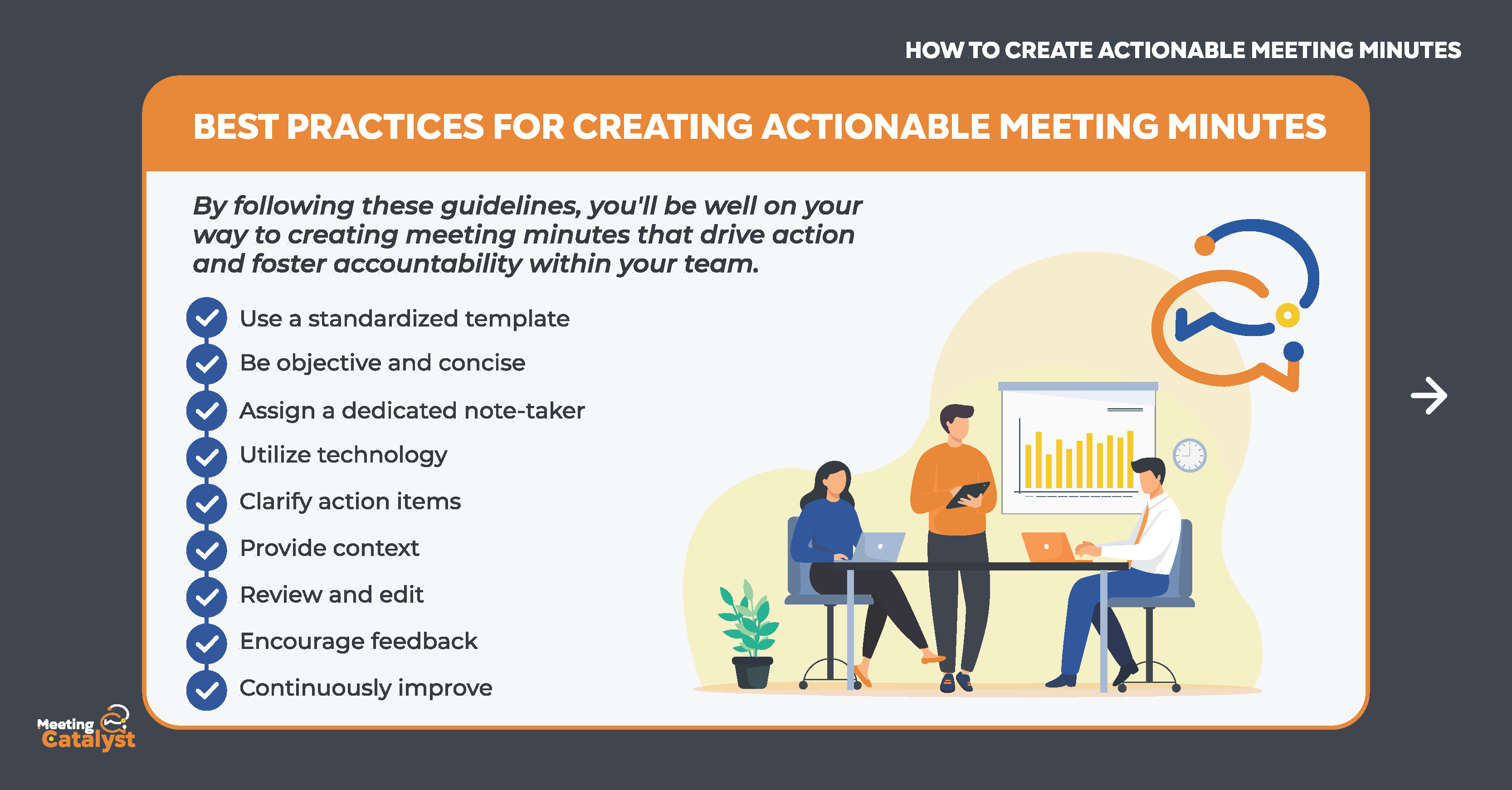
Now that we've covered the key steps for creating actionable meeting minutes, let's take a moment to summarize these best practices and provide additional tips and tricks for ensuring that your minutes are effective and actionable. By following these guidelines, you'll be well on your way to creating meeting minutes that drive action and foster accountability within your team.
Use a standardized template: A consistent template with clear sections and formatting will make your meeting minutes easier to read and understand. It also helps ensure that you capture all the important information from your meetings.
Be objective and concise: Keep your meeting minutes neutral and avoid including personal opinions or biases. Focus on documenting the key points, decisions, and action items in a clear and concise manner.
Assign a dedicated note-taker: Having a dedicated note-taker allows the meeting leader and participants to focus on the discussion while ensuring that accurate and detailed minutes are recorded.
Utilize technology: Consider using note-taking apps, transcription services, or other technology tools to help streamline the process of capturing and organizing meeting minutes.
Clarify action items: Clearly identify and document action items, along with the responsible person(s) and deadlines. This will help ensure that tasks are completed on time and that progress is tracked effectively.
Provide context: When necessary, provide background information or context to help readers understand the significance of decisions or discussions.
Review and edit: Before distributing your meeting minutes, take the time to review and edit them for accuracy, completeness, and readability.
Encourage feedback: Invite meeting participants to review the minutes and provide feedback, ensuring that everyone is on the same page and that any inaccuracies or omissions are addressed.
Continuously improve: Regularly evaluate and refine your meeting minute practices to ensure that they remain effective and actionable. Seek feedback from your team and stay informed about best practices in the field.
By following these best practices, you'll create actionable meeting minutes that drive progress and foster accountability within your team. Remember, the key to success is continuous improvement and iteration, so don't be afraid to make adjustments and learn from your experiences as you work towards creating better meeting minutes.
Conclusion
Creating actionable meeting minutes is an essential skill for business and team leaders who want to improve their meetings and ensure that important information, decisions, and action items are effectively documented and communicated. By following the steps and best practices outlined in this article, you'll be well on your way to producing meeting minutes that drive action, foster accountability, and contribute to the overall success of your team.
To recap, remember to:
- Set clear goals for your meeting minutes
- Prepare for your meeting
- Take effective meeting notes
- Review and refine your meeting minutes
- Distribute your meeting minutes effectively
Don't forget to continuously seek feedback and refine your approach as you work towards perfecting your meeting minute practices.
Now is the time to take action and start implementing these strategies in your own meetings. By doing so, you'll not only enhance the effectiveness of your meetings, but you'll also contribute to the overall success and growth of your organization.